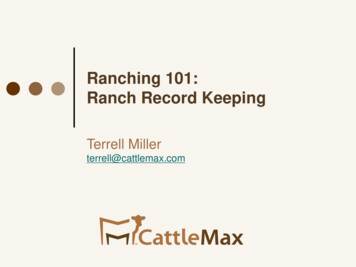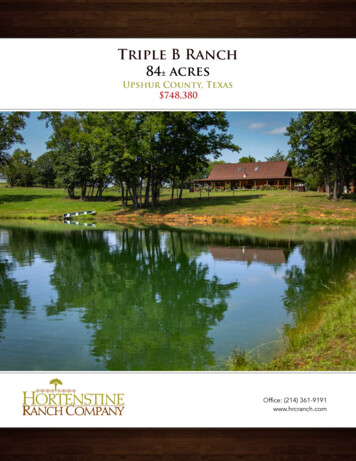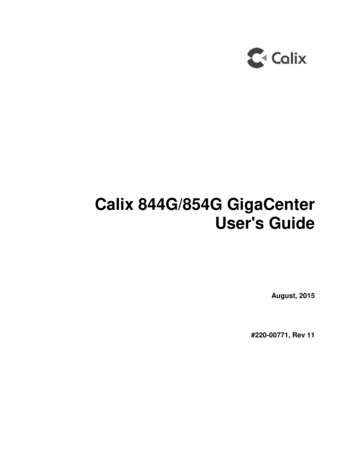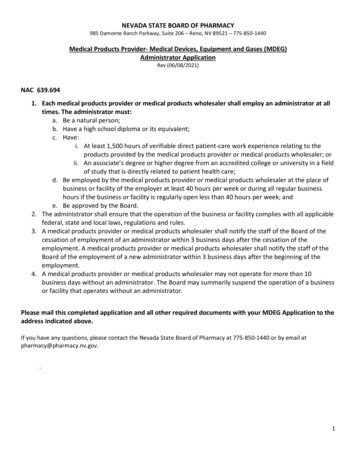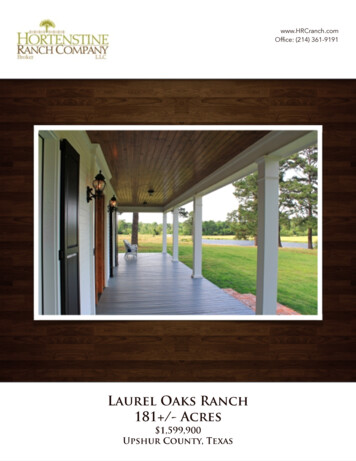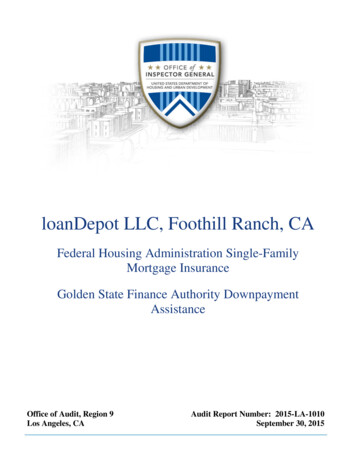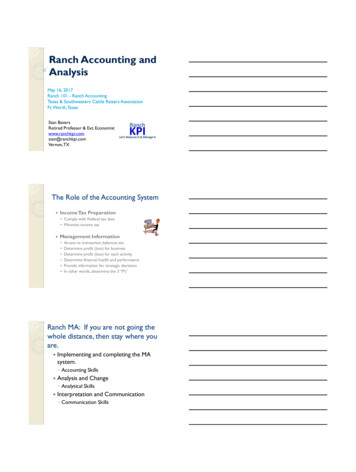
Transcription
Ranch Accounting andAnalysisMay 16, 2017Ranch 101 - Ranch AccountingTexas & Southwestern Cattle Raisers AssociationFt. Worth, TexasStan BeversRetired Professor & Ext. XThe Role of the Accounting System Income Tax Preparation Comply with Federal tax laws Minimize income tax Management Information Access to transaction, balances, etc.Determine profit (loss) for businessDetermine profit (loss) for each activityDetermine financial health and performanceProvide information for strategic decisionsIn other words, determine the 3 “P’s”Ranch MA: If you are not going thewhole distance, then stay where youare. Implementing and completing the MAsystem. Analysis and Change Interpretation and Communication Accounting Skills Analytical Skills Communication Skills
Who is involved with theInformation System & Who is inControl Lender Tax Accountant Data Entry Person (Daily Grind:Bookkeeper) Information User (Information manager:both financial and production)Who is involved with theInformation System & Who is inControl Lender Becomes the “quasi” information manager and user. Motive: Board Members/ Owners & Bank Auditors Tax Accountant Motive: Lower the producers tax liability. Probablywants to keep you as a customer. Are they doing therancher a favor or not?Who is involved with theInformation System & Who is inControl Data Entry Person (Daily Grind: Bookkeeper) Usually the spouse or the rancher. Either the system must be simple and user-friendly, or else thisperson better have some accounting skills. Serves as the “Soul” of the system. Motive: Typically thinks their motivation is to the tax accountant,however should be to the following Information User (Information manager: bothfinancial and production) This is where most ranchers fall down. Don’t know how to generate it and/or don’t know how tointerpret and use the information. Motive: Doesn’t exist for most operations.
Start your Ranch MA with the “EndProducts” in mind Ranchers are always told, “you need good financialrecords” but what is that? Meaningful information, which can impact the management of thebusiness We defined the End Product to be: Financial Statements Beginning and Ending Balance Sheet Profit and Loss Statement Financial Analysis as defined by the Sweet 16 ratios asrecommended by the FFSC. Profit & Loss by Class Total Unit Cost (TUC) Commodity Cycle Reports Ultimately KPI’s defined by the teamQuestion: How do we get there?QuickBooks Pro will partially get youthere, however, some accountingknowledge is required and the program’sflexibility can cause problems. Need some type of Livestock Inventorysystem. Integration of the two? Managerial Accounting UsingQuickBooks Pro Create the system with the end product inmind.Create a rigid structure for QB Pro and Idon’t give the user many choices. My Ranch Chart of Accounts Your Class List using My Approach. Follow the Timeline Introduction to QuickBooks Pro (Daily Grind) Advanced QuickBooks Pro (The Rest of the Story) Incorporate Microsoft Excel or some otherspreadsheet.
Accounting & Analysis ataReports-P&L-P&L by class-TUC-CommodityManagement vs. Tax Accounting How is “tax” integrity maintained? MA transactions take place below “NetOrdinary Income” Except for depreciation, mgmt. labor, cost ofgood sold, gains/losses on sale of assets. Your tax preparer should re-calculate MA transactions accomplished with“classes” and additional accountsManagement vs. Tax Accounting Major differences Tax cash, MA accrual adjustedDepreciation methodCapitalizationHandling of “management and labor”However, within the MA system, taxintegrity is maintained
Management vs. Tax Accounting Depreciation Differs Tax accelerated sec 179 Book represents allocation of asset’s costover useful life Book depreciation can be easily provided withminimal cost, or in some operations, you may want topurchase your own “fixed asset” softwareManagement vs. Tax Accounting Capitalization of raised livestock andestablishment cost of crops Only if determinable useful life If indeterminable, must expense in currentyear BIG PROBLEM with the cow-calf industry Without this, you never really know thefinancial health of your cow herd.Management vs. Tax Accounting MA includes management (owner)labor as expense (non-deductible) There is value to the services that youprovide your ownership. If there wasn’t youwouldn’t be doing it I encourage you to write yourself a check(withdrawals) and deposit it into a personalaccount What would it cost you to hire someone todo what you do?
Management vs. Tax Accounting Accumulated costs for incompleteclasses are transferred to B/S Use journal entry to increase “Investment in ” account (current asset) and decreaseexpense for that class Recognized as expense in year income occurs(matching principle)MA System Design QuickBooks Pro“This is a 250 program with a 5000 design” Works with Excel to integrate production data Expanded chart of accounts “Step up” accounting Profit, cost and support centers, where the profitscenters must pay all expenseImplementing the MA SystemChart of accountsSet up classes The daily grind Reconcile bank accounts Reconcile loans ** Other resources used (Mgmt Labor) Examine P&L by class Year end activities Create and analyze reports
Implementing the MA System Import Ranch ManagerialAccounting chart of accounts Add & delete accounts to fit your operation(use caution) Understand the transfer accounts Includes B\S accounts Get to know your COA Print COA for referenceEvery Operation is Made up of VariousPieces. All Can, and Need, to be ManagedMy Agricultural OperationProfit CentersCost CentersSupport CentersImplementing the MA System Set up class list Use sub-classes of PC, CC, SC PC (Profit Center) those activities (commodities)that sell a product at the end of the productioncycle CC (Cost Center) “factories” that accumulatecosts to be transferred and paid by other PCs SC (Support Center) types of expenses thatcannot readily be allocated and will eventually bepaid by PCs
Implementing the MA System Support Centers InterestMachinery & Equipment (M&E)Labor & Management (L&M)General & Administrative (G&A)These are always the sameCan be Considered the “Fixed Costs” ofthe Operation Is L&M Fixed?Implementing the MA System Cost Centers Cow-calf (maybe)‘16 Replacement Heifers‘15 Replacement HeifersHay ProductionGrazingHere, you begin to customize the systemto your operationImplementing the MA System Profit Centers ‘15 Yearling Heifers‘15 Yearling Steers‘16 Weaned CalvesWildlifeCow-calf (maybe)Continue to customize the system toyour operation
Implementing the MA SystemTime Line“Daily Grind”Check Unclassified Column3. Track Loans- Loan Transaction Histories4. Update Asset List (Additions &Disposals)5. Book Accrual Adjustments (Mgmt Labor& Other Resources Used)6. Is it reasonable?1.2.Implementing the MA SystemTime LineAllocate Support CentersTransfer Cost CentersCapitalize Unfinished Profit CentersReports7.8.9.10. Profit & Loss by ClassFinAnalysisTotal Unit CostCommodity ReportsImplementing the MA System The daily grind Not much more than you should be doingalready Assign account and class to every transactionthat affects the Profit & Loss Statement Develop your routine and be consistent
Implementing the MA System Reconcile accounts Bank accounts (checking) Payables Clean up bills to be paid Were note payments handled correctly?(principle vs. interest)Implementing the MA System Reconcile Loans Get “Loan Transaction History” from creditor Reconcile each loan advance and each payment with QuickBooks Asset disposals/additions “Book” asset disposals Was purchase made with check or loan proceeds? Was there atrade involved? Management Labor Your labor is a resource that was used by the business!Seek advice or services of an accountingprofessionalImplementing the MA System(Accounting Short Course) When you sell an asset, are the proceedsconsidered Income? Answer: Only the gain/loss on the sale isconsidered income/expense.Cost of Asset- Accum. DepreciationBasis-ProceedsBasisGain/Loss
Implementing the MA System Examine P&L by class monthly Watch for “unclassified” transactions Were transactions classified correctly? Memorize re-occurring transactionsYear End Activities Accrual adjustments Prepaid expenses, payables, receivablesManagement laborInventoryDepreciation (straight-line basis)Allocate support centers (Excel worksheets)Transfer cost centers (Excel worksheets)Send “incomplete” centers to the balancesheetCompile reports (Excel worksheets)REAL LIFE EXAMPLESlides taken from a specific ranch and it’smanager’s presentation at the Board ofDirectors meeting. Salary committeemeeting to determine ranch manager’scompensation followed this presentation.
Real Life Example SC G&A Allocation 202,513 (36%) PC: Cow-calf 30,377 (5%) PC: ’13 Yearlings 4,050 (1%)PC: Grain Dry 20,251 (4%) PC: Grain Irrig 562,985 2,025 (1/2%) PC: Wildlife 182,261 (32%) CC: Hay Production 121,508 (22%) CC: ‘13 Rep HeifersAfter allocations are made, all support centers shouldhave a zero net income.YEA – ReportsP&L (Net Ordinary Income) to CPAP&L by class and balance sheet Fin Analysis Total Unit Cost Report Commodity Reports Note: Bottom 2 reports combine withproduction data3,500 Beef Cow Ranch2011ROANet Income fromOperationsAsset Turnover RatioOperating ExpenseRatioInterest 4.57%20.02%7.44% 724,470 1,367,148 1,283,677 1,687,673 2,312,529 45.0%0.0%0.0%0.0%0.0%0.0%0.0%Depreciation ExpenseRatio26.7%22.3%25.3%22.4%19.4%28.6%Net Income Ratio28.4%42.5%39.0%42.7%49.6%26.4%
3,500 Beef Cow Ranch2011ROANet Income %14.57%20.02%7.44% 724,470 1,367,148 1,283,677 1,687,673 2,312,529 45.0%Asset Turnover RatioOperating ExpenseRatioInterest ExpenseRatio0.0%0.0%0.0%0.0%0.0%0.0%Depreciation ExpenseRatio26.7%22.3%25.3%22.4%19.4%28.6%Net Income Ratio28.4%42.5%39.0%42.7%49.6%26.4%Percentage of Operating ExpensesLaborFeedCustom HireVetFertilizerRentsPro ls3%12%Gas, Fuel, %3,500 Beef Cow Ranch20112012201420152016 678.82 723.31 713.32 787.56 787.26 757.24Cow-calf (/ Cwt. Weaned) 98.35 106.77 99.11 109.75 131.97 119.37Hay Production (/ Ton) 62.98 70.59 61.01 96.41 79.96 61.45Replacement Heifer (/Head) 1,028 1,281 1,076 1,128 1,246 1,231Cow-calf (/ Female)2013
Key Performance IndicatorsBased on management and Board ofDirector input, Key PerformanceIndicators (KPI’s) have been established They include both production andfinancial measures These indicators are use to evaluateperformance and establish goals KPIProductionPregnancy percentageCalving percentage Weaning percentage Weaning weight per head Lbs. weaned per cow exposed Total cost per cow Unit cost of weaned calf (break even) KPIMarket Price versus Unit Cost (Breakeven)Unit Cost/Calf per CWTPrice Received 250 200 150 100 50 200820092010201120122013201420152016
KPITotal Cost per Breeding Cow 800 750 700 650 600 550 500 lWorking capitalROA Net Income from Operations (pre interest & income tax) Ratios Operating ExpenseDepreciation ExpenseInterest ExpenseNet Income from OperationsFinancial KPI: ROA2520151050200820092010201120122013201420152016
Financial KPI: Operating RatiosOperating ExpensesDepreciationNet 0201120122013201420152016MA: If you are not going the wholedistance, then stay where you are. Implementing and completing the MAsystem. Analysis and Change Accounting Skills Analytical Skills Interpretation and Communication Communication SkillsContact InformationStan BeversRetired Professor & Ext. Economistwww.ranchkpi.com11861 US Highway 183Vernon,TX 76384940 om
Reconcile each loan advance and each payment with QuickBooks Asset disposals/additions “Book” asset disposals Was purchase made with check or loan proceeds? Was there a trade involved? Management Labor Your labor is a resource that was used by the busine
